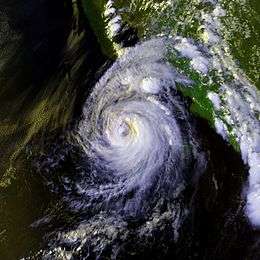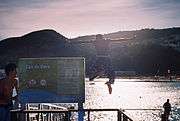Summer

| Part of the nature series |
| Weather |
|---|
| Calendar seasons |
| Tropical seasons |
| Storms |
| Precipitation |
| Topics |
|
|
Summer is the hottest of the four temperate seasons, falling between spring and autumn. At the summer solstice, the days are longest and the nights are shortest, with day-length decreasing as the season progresses after the solstice. The date of the beginning of summer varies according to climate, tradition and culture and vice versa. When it is summer in the Northern Hemisphere, it is winter in the Southern Hemisphere, and vice versa.
Timing
From an astronomical view, the equinoxes and solstices would be the middle of the respective seasons,[1][2] but sometimes astronomical summer is defined as starting at the solstice, the time of maximal insolation, or on the traditional date of June 21. A variable seasonal lag means that the meteorological center of the season, which is based on average temperature patterns, occurs several weeks after the time of maximal insolation.[3] According to meteorologists,[4][5] summer extends for the whole months of June, July, and August in the northern hemisphere and the whole months of December, January, and February in the southern hemisphere. Under meteorological definitions, all seasons are arbitrarily set to start at the beginning of a calendar month and end at the end of a month.[4] This meteorological definition of summer also aligns with the commonly viewed notion of summer as the season with the longest (and warmest) days of the year, in which daylight predominates. The meteorological reckoning of seasons is used in Australia, Austria, Denmark, the former Soviet Union and Japan. It is also used by many in the United Kingdom. In Ireland, the summer months according to the national meteorological service, Met Éireann, are June, July and August. However, according to the Irish Calendar, summer begins on 1 May and ends on 1 August. School textbooks in Ireland follow the cultural norm of summer commencing on 1 May rather than the meteorological definition of 1 June.
Days continue to lengthen from equinox to solstice and summer days progressively shorten after the solstice, so meteorological summer encompasses the build-up to the longest day and a diminishing thereafter, with summer having many more hours of daylight than spring. Reckoning by hours of daylight alone, summer solstice marks the midpoint, not the beginning, of the seasons. Midsummer takes place over the shortest night of the year, which is the summer solstice, or on a nearby date that varies with tradition.
Where a seasonal lag of half a season or more is common, reckoning based on astronomical markers is shifted half a season.[6] By this method, in North America, summer is the period from the summer solstice (usually 20 or 21 June in the Northern Hemisphere) to the autumn equinox.[7][8][9][10]
Reckoning by cultural festivals, the summer season in the United States is commonly regarded as beginning on Memorial Day weekend (the last weekend in May) and ending on Labor Day weekend (the first weekend in September), more closely in line with the meteorological definition for the parts of the country that have four-season weather. The similar Canadian tradition starts summer on Victoria Day one week prior (although summer conditions vary widely across Canada's expansive territory) and ends, as in the United States, on Labour Day.
In Chinese astronomy, summer starts on or around 5 May, with the jiéqì (solar term) known as lìxià (立夏), i.e. "establishment of summer", and it ends on or around 6 August.
In southern and southeast Asia, where the monsoon occurs, summer is more generally defined as lasting from March, April, May and June, the warmest time of the year, ending with the onset of the monsoon rains.
Because the temperature lag is shorter in the oceanic temperate southern hemisphere,[11] most countries in this region use the meteorological definition with summer starting on 1 December and ending on the last day of February.[12][13]
In Australia and New Zealand, summer officially begins on 1 December and ends on the last day of February (29 February on a leap year, 28 February otherwise).
Weather

Summer is traditionally associated with hot or warm weather. In the Mediterranean regions, it is also associated with dry weather, while in other places (particularly in Eastern Asia because of the Monsoon) it is associated with rainy weather. The wet season is the main period of vegetation growth within the savanna climate regime.[14] Where the wet season is associated with a seasonal shift in the prevailing winds, it is known as a monsoon.[15]

In the northern Atlantic Ocean, a distinct tropical cyclone season occurs from 1 June to 30 November.[16] The statistical peak of the Atlantic hurricane season is 10 September. The Northeast Pacific Ocean has a broader period of activity, but in a similar time frame to the Atlantic.[17] The Northwest Pacific sees tropical cyclones year-round, with a minimum in February and March and a peak in early September. In the North Indian basin, storms are most common from April to December, with peaks in May and November.[16] In the Southern Hemisphere, the tropical cyclone season runs from 1 November until the end of April with peaks in mid-February to early March.[16][18]
Thunderstorm season in the United States and Canada runs in the spring through summer. These storms can produce hail, strong winds and tornadoes, usually during the afternoon and evening.
Holidays
School breaks
Schools and universities typically have a summer break to take advantage of the warmer weather and longer days. In almost all countries, children are out of school during this time of year for summer break, although dates vary. In the United States, public schools usually end in early June while colleges get out in early May. Although some schools get out on the last or second last Thursday in May. In India, school ends in April end and resumes in late June or early July. In England and Wales, school ends in mid-July and resumes again in early September; in Scotland, the summer holiday begins in late June and ends in mid- to late-August. Similarly, in Canada the summer holiday starts in late June and end at the very start of September. In Russia the summer holiday begins in the end of May and ends at August, 31. In the Philippines, the months of April and May make up the summer break[19] In the Southern Hemisphere, school summer holiday dates include the major holidays of Christmas and New Year's Day. School summer holidays in Australia, New Zealand and South Africa begin in early-December and end in early February, with the dates varying between states. In Cameroon and Nigeria, schools usually go for summer vacation in mid-July and resume back in the later weeks of September or first week of October.
Public holidays
A wide range of public holidays fall during summer, including:
- Memorial Day (United States) or Victoria Day (Canada) through Labor Day in Summer
- Bank holidays in the United Kingdom and Ireland
- Ólavsøka, national holiday in the Faroe Islands on 29 July
- Independence Day in the United States (4 July)
- Australia Day (26 January)
- Canada Day (1 July)
- Bastille Day, National Day of France (14 July)
- Festa della Repubblica, Italian national day and republic day (2 June)
- National Day of Sweden (6 June) and Midsummer, sometimes referred to as the alternative National Day.
Activities
People take advantage of the warmer temperatures by spending more time outdoors during the summer. Activities such as traveling to the beach and picnics occur during summer months. Sports such as association football, basketball, American football, volleyball, skateboarding, baseball, softball, cricket, tennis, golf and water polo are played. Water sports also occur. These include water skiing, wake boarding, swimming, surfing, and tubing. The modern Olympics have been held during the summer months every four years since 1896. The 2000 Summer Olympics, in Sydney, however, were held during the Australian spring.
Summer is usually a low point in television viewing, and television schedules generally reflect this by not scheduling new episodes of their most popular shows between the end of May sweeps and the beginning of the television season in September, instead scheduling low-cost reality television shows and burning off commitments to already-canceled series. There is an exception to this with children's television. Many television shows made for children and are popular with children are released during the summer months, especially on children's cable channels such as the Disney Channel in the United States, as children are off school. Disney Channel, for example, ends its preschool programming earlier in the day for older school age children in the summer months while it reverts to the original scheduling as the school year begins. Conversely, the music and film industries generally experience higher returns during the summer than other times of the year and market their summer hits accordingly. The summer season is also most popular for animated movies to be released theatrically in movie theaters.
With most school-age children and college students (except those attending summer school) on summer vacation during the summer months, especially in the United States, travel and vacationing traditionally peaks during the summer, with the volume of travel in a typical summer weekend rivaled only by Thanksgiving. Teenagers and college students often take summer jobs in industries that cater to recreation. Business activity for the recreation, tourism, restaurant, and retail industries peak during the summer months as well as the holiday season.
|
See also
References
| Wikiquote has quotations related to: Summer |
| Look up summer in Wiktionary, the free dictionary. |
| Wikimedia Commons has media related to Summer. |
- ↑ Ball, Sir Robert S (1900). Elements of Astronomy. London: The MacMillan Company. p. 52. ISBN 978-1-4400-5323-8.
- ↑ Heck, Andre (2006). Organizations and strategies in Astronomy. 7. Springer. p. 14. ISBN 1-4020-5300-2. Retrieved September 15, 2015.
- ↑ Cecil Adams (1983-03-11). "Is it true summer in Ireland starts May 1?". The Straight Dope. Retrieved 2011-09-27.
- 1 2 Meteorological Glossary. London: HMSO. p. 260. ISBN 0-11-400363-7.
- ↑ A meteorologist defines summer
- ↑ Driscol, D. M.; Rice, P. B.; Fong, J. M. Y. (1994). "Spatial variation of climatic aspects of temperature: Interdiurnal variability and lag". International Journal of Climatology. 14 (9): 1001. Bibcode:1994IJCli..14.1001D. doi:10.1002/joc.3370140905.
- ↑
- ↑ "First day of summer worth celebrating". JSOnline. Retrieved 2011-09-27.
- ↑ "Father's Day is first day of summer". Fox11online.com. 2009-06-19. Retrieved 2011-09-27.
- ↑ "Summer Solstice - from Eric Weisstein's World of Astronomy". Scienceworld.wolfram.com. Retrieved 2011-09-27.
- ↑ Gabler, Robert E.; Petersen, James F.; Trapasso, L. Michael; Sack, Dorothy (2008). Physical Geography. Belmont, California: Cengage Learning. p. 107. ISBN 0495555061. ISBN 9780495555063.
- ↑ Williams, Jack (2005-02-22). "Answers: When do the seasons begin". Usatoday.Com. Retrieved 2011-09-27.
- ↑ "Bureau of Meteorology - Home Page". Bom.gov.au. 2011-03-11. Retrieved 2011-09-27.
- ↑ Charles Darwin University (2009). Characteristics of tropical savannas. Charles Darwin University. Retrieved on 27 December 2008.
- ↑ Glossary of Meteorology (2009). Monsoon. American Meteorological Society. Retrieved on 16 January 2009.
- 1 2 3 Atlantic Oceanographic and Meteorological Laboratory, Hurricane Research Division. "Frequently Asked Questions: When is hurricane season?". National Oceanic and Atmospheric Administration. Retrieved 25 July 2014.
- ↑ McAdie, Colin (10 May 2007). "Tropical Cyclone Climatology". National Hurricane Center. Retrieved 9 June 2007.
- ↑ "Tropical Cyclone Operational Plan for the Southeastern Indian Ocean and the South Pacific Oceans" (PDF). World Meteorological Organization. 10 March 2009. Retrieved 6 May 2009.
- ↑ Filipino National



